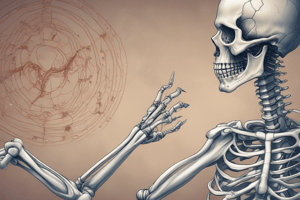Podcast
Questions and Answers
If a person's body isn't producing enough red blood cells, which part of the skeletal system is likely not functioning correctly?
If a person's body isn't producing enough red blood cells, which part of the skeletal system is likely not functioning correctly?
- Compact Bone
- Cartilage
- Red Marrow (correct)
- Joints
Which of the following is NOT a primary function of the skeletal system?
Which of the following is NOT a primary function of the skeletal system?
- Facilitating movement
- Regulating body temperature (correct)
- Providing shape and support
- Protecting internal organs
What type of joint is the elbow?
What type of joint is the elbow?
- Hinge (correct)
- Ball and Socket
- Fixed
- Pivot
If someone has a condition that causes excessive breakdown of bone tissue, which type of cell is likely overactive?
If someone has a condition that causes excessive breakdown of bone tissue, which type of cell is likely overactive?
What is the primary role of articular cartilage?
What is the primary role of articular cartilage?
Which component of bone tissue provides its hardness?
Which component of bone tissue provides its hardness?
What is the function of yellow marrow?
What is the function of yellow marrow?
Which type of joint provides the greatest range of motion?
Which type of joint provides the greatest range of motion?
What connects the skeletal system to the muscular system to facilitate movement?
What connects the skeletal system to the muscular system to facilitate movement?
What is the main difference between compact and spongy bone?
What is the main difference between compact and spongy bone?
Flashcards
Skeletal System
Skeletal System
The framework of the human body consisting of bones, cartilage, joints, and marrow.
Functions of Skeletal System
Functions of Skeletal System
Four jobs: protect organs, shape body, provide movement, produce blood cells.
Number of Bones
Number of Bones
There are approximately 206 bones in an adult human body.
Compact Bone
Compact Bone
Signup and view all the flashcards
Spongy Bone
Spongy Bone
Signup and view all the flashcards
Osteoblasts
Osteoblasts
Signup and view all the flashcards
Osteoclasts
Osteoclasts
Signup and view all the flashcards
Cartilage
Cartilage
Signup and view all the flashcards
Types of Joints
Types of Joints
Signup and view all the flashcards
Bone Marrow
Bone Marrow
Signup and view all the flashcards
Study Notes
Skeletal System Overview
- The skeletal system is the framework of the human body.
- It has four key functions:
- Protecting internal organs.
- Providing shape and support to the body.
- Enabling movement.
- Producing red blood cells.
Skeletal System Components
- The skeletal system is composed of:
- Bones
- Cartilage
- Joints
- Marrow
Bones
- There are approximately 206 bones in the adult human body.
- Bones have a hard outer layer made of phosphorus and calcium.
- Beneath this layer are nerves and blood vessels.
- The inside structure of a bone is called spongy bone.
- The hard, outer layer is called compact bone.
- Cells called osteoblasts build new bone.
- Cells called osteoclasts recycle and break down bone.
- Bone-building and breakdown are constant processes.
Cartilage
- Cartilage is a soft connective tissue found in areas like the ears and the tip of the nose.
- A specific type of cartilage in joints is called articular cartilage.
- Articular cartilage is smooth and covers the surfaces of joints.
Joints
- Joints are where two or more bones connect.
- A variety of joint types exist.
- Synovial joints enable movement.
- Some examples include ball-and-socket, hinge, and pivot joints
- Over 400 joints allow for movement in the body.
Marrow
- Marrow is soft, connective tissue located inside bones.
- Two types of marrow exist:
- Red marrow produces blood cells.
- Yellow marrow stores fat.
Skeletal System Connections
- The skeletal system connects to other body systems:
- The Muscular System: helps movement
- The Circulatory System: produces red blood cells.
Studying That Suits You
Use AI to generate personalized quizzes and flashcards to suit your learning preferences.
Related Documents
Description
Explore the skeletal system's key functions: organ protection, body support, movement, and red blood cell production. Learn about its components, including bones, cartilage, joints, and marrow. Discover the roles of osteoblasts and osteoclasts in bone maintenance.




